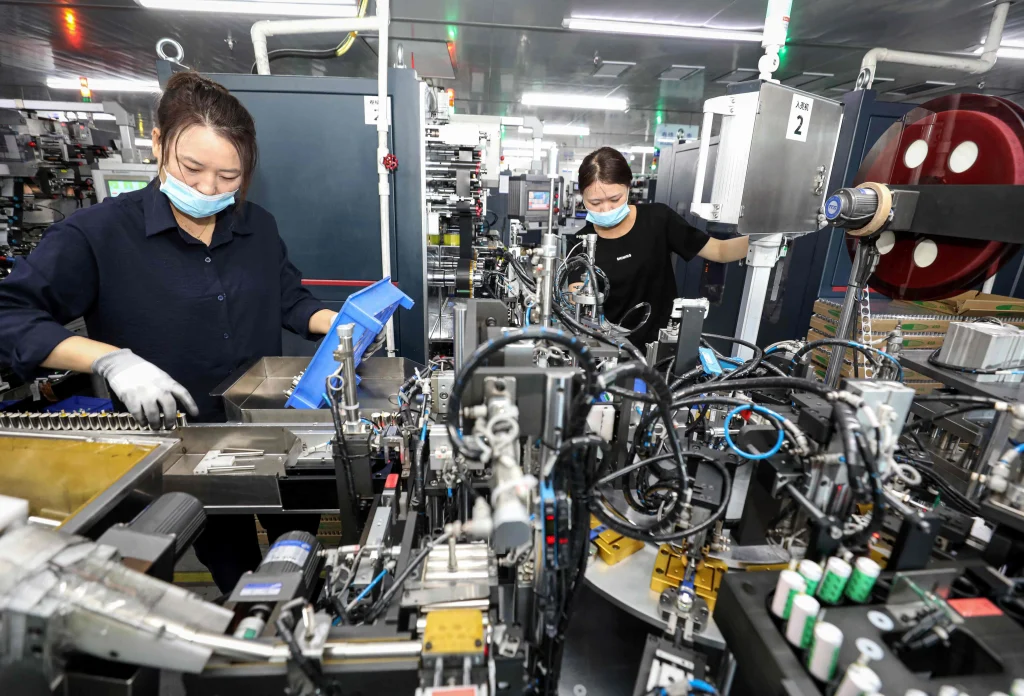[BEIJING] China’s factory activity contracted at the fastest pace in 16 months in April, a factory survey showed on Wednesday (Apr 30), keeping alive calls for further stimulus as US President Donald Trump’s “Liberation Day” package of tariffs snapped two months of recovery.
The reading contrasts with Chinese officials’ conviction that the world’s second-largest economy is well placed to absorb the US trade shock and suggests domestic demand remains weak as factory owners struggle to find alternative buyers overseas.
Manufacturers had been front-loading outbound shipments in anticipation of the duties, but the arrival of the levies has called time on that strategy – putting pressure on policymakers to finally address rebalancing the economy.
China’s official purchasing managers’ index (PMI) fell to 49 in April versus 50.5 in March, according to the National Bureau of Statistics (NBS), the lowest reading since December 2023 and missing a median forecast of 49.8 in a Reuters poll.
The non-manufacturing PMI, which includes services and construction, fell to 50.4 from 50.8, but remained above the 50-mark separating growth from contraction.
“The sharp drop in the PMIs likely overstates the impact of tariffs due to negative sentiment effects, but it still suggests that China’s economy is coming under pressure as external demand cools,” Zichun Huang, China economist at Capital Economics, said. “Although the government is stepping up fiscal support, this is unlikely to fully offset the drag, and we expect the economy to expand just 3.5 per cent this year.”
BT in your inbox

Start and end each day with the latest news stories and analyses delivered straight to your inbox.
Huang added that negativity among the survey’s respondents “probably exaggerates the impact of the tariffs,” noting that “the new export orders index dropped back to its lowest level, Covid-19 disruptions aside, since April 2012.”
Trump’s decision to single Beijing out for import duties of 145 per cent comes at a particularly difficult time for China, which is struggling with deflation due to sluggish income growth and a prolonged property crisis.
Beijing has largely relied on exports to shore up the fragile economic recovery since the end of the pandemic and only began to take steps to boost domestic demand more earnestly late last year.
Zhao Qinghe, an NBS statistician, said the drop was largely down to “sharp changes in (China’s) external environment,” in a note accompanying the release.
A separate private sector survey also released on Wednesday showed a sharp fall in new export orders and overall factory activity slowing.
China’s renminbi inched lower against the US dollar following the data’s release, as the first data since Trump’s tariff announcement pointed to early signs of damage to the economy.
Buying time
China has repeatedly denied it is seeking to negotiate with the US a way out of the tariffs, and appears to instead be betting that Washington makes the first move. As such, Beijing has advanced this year’s stimulus plans to mitigate the economic pain of losing, at least temporarily, its biggest customer.
“We expect the manufacturing PMI to be in contraction in May, but it is expected to rise to about 49.5, driven by an increase in stable growth policies,” said Wang Qing, chief macro analyst at Oriental Jincheng.
He said further cuts to interest rates and the amount commercial banks must hold in reserve may be needed as conditions worsen.
On Monday, the vice head of China’s state planner said the National Development and Reform Commission (NDRC) would roll out new policies over the second quarter in line with the prevailing economic conditions of the time.
That followed pledges by the Communist Party’s elite decision-making body, the Politburo, on Friday to support firms and workers most affected by the duties.
The general consensus among China observers is a second trade war with the US will significantly weigh on growth, but the NDRC’s Zhao Chenxin said he was confident the country would achieve its 2025 economic growth target of around 5 per cent.
The International Monetary Fund, Goldman Sachs and UBS all recently revised down their economic growth forecasts for China over 2025 and into 2026, citing the impact of US tariffs – none of them expect the economy to hit Beijing’s official growth target. REUTERS


